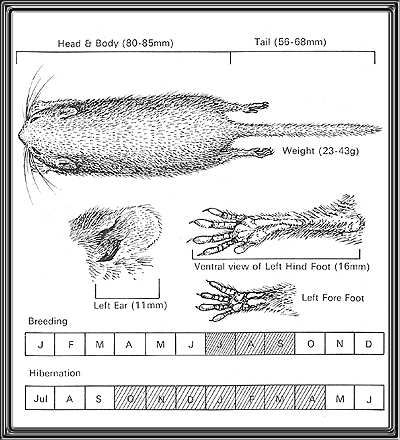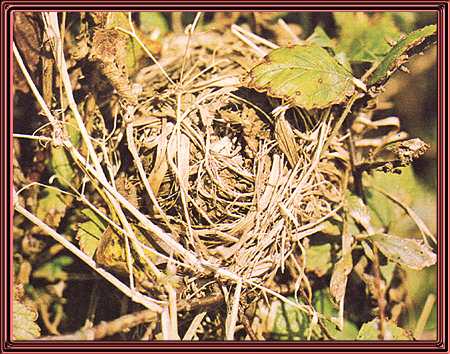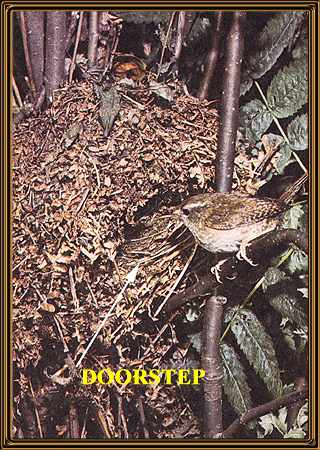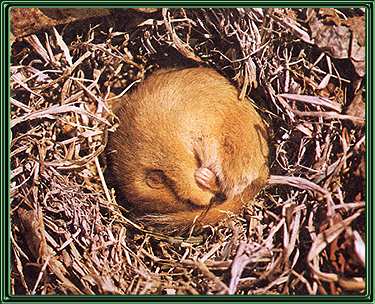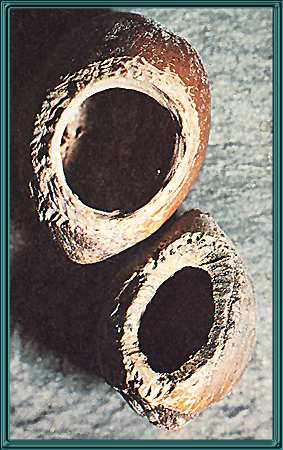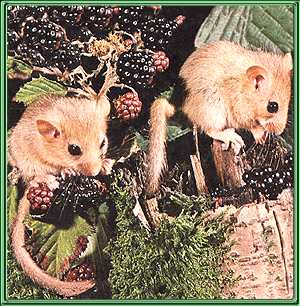
Muscardinus avellanarius
(The Common Dormouse)
Dormice are small rodents with soft, orange-brown fur and long tails of a similar colour which are furred all over. They are such attractive animals that many people would like to be able to watch them but because they are almost entirely nocturnal this presents a challenge to observers.
The main chance of seeing one would be at twilight when many changes are taking place. For almost all birds it is time to go to roost and to finish the day's activities but for many animals it is the reverse: they are beginning their main spell of activity.In Britain this small mammal is known as the 'common dormouse' but a more appropriate name would be the hazel dormouse. The animal's scientific name, as above, shows the deep connection with the hazel tree whose scientific name is(Corylus avellana). Dormouse in German is Haselmaus another connection with hazel, and in French it is Muscardin. The fact that the dormouse hibernates is reflected in some of the local English names. In the counties of Hampshire and Cornwall it is known as 'dory mouse' and 'dozing mouse' respectively: in many counties it is known as the 'sleeper', the 'seven sleeper', or 'sleep mouse'. It's attractive appearance has a fairy tale charm and other delightful local names include 'chestle crumb' and 'derry mouse'.
Dormice belong to the mammalian order Rodentia and to the family Gliridae. Rats and mice belong to the family Muridae. Dormice have four upper and lower cheek teeth whereas rats and mice have only three. The tooth patterns of crosswise ridges on the molar teeth are distinctive to the dormouse and therefore important for identification.
The head and body measured together are 80-85 mm and the tail is 56-68 mm. The weight of the animal varies from 23 to 43 grams depending on the time of year. A dormouse is heaviest just before it starts hibernating. It is readily distinguished from other mice by its rounded, compact shape and more especially by its orange-brown coat and thick bushy tail. The general impression is of a light coloured animal, although, in fact, the orange-brown fur on its upper parts have a light sprinkling of darker hairs but these are thinly scattered. The tip of the tail may also be darker. The underparts are much paler, sometimes pure white. Young dormice are much greyer, the rich colour of the adult coming only during the first winter, while the animal is hibernating. Albino dormice are rare but dormice with white tips to the tail are recorded a little more often. The most striking features of the head are the fine, black whiskers - these can be as long as 25-30 mm long - and the large, prominent black eyes. When moving about in the dark, the whiskers are used as sense organs, as with all mice, they quiver repeatedly even when the animal is still. The ears are not large but rounded, showing clearly above the fur.
Dormice spend a lot of time climbing about amongst branches and twigs. They are well adapted to arboreal (tree) life. Their front limbs are short. Both front and back feet are prehensile (capable of grasping) and, as the front feet can be turned out sideways - almost at right angles to the body - twigs and branches can be clasped firmly and easily. The furry tail is not prehensile. The dormouse has four fully developed digits on each foot and there is a gap separating the fourth and fifth digit on the hind feet. The digits are long and slender and covered with short downy fur on the upper surfaces; they end in strong short claws. On the upper surfaces there are well-developed pads which help keep a firm grip as it climbs.
This guy is a bit of an acrobat..!
Distribution: The hazel dormouse, a European mammal, is found from the woods of Sweden in the north to the slopes of the Alps in the south. It is not found in Spain or Denmark but is found eastwards to the Volga and into Asia Minor. It is regarded as a comparative newcomer to the British fauna, having spread westwards from south central Europe during the Pleistocene Age, less than a million years ago. There are many fossil remains of dormice on the European continent but so far none appear to have been discovered in Britain. At present it is found in England and Wales but not in Scotland and Ireland. In Wales it occurs in the border counties between Wales and England but only in local pockets elsewhere. In England it is found more often in the southern counties than in the north. It is scarce in the Midlands and, although present in Sussex, Surrey, Kent and Essex and a few places in Suffolk, eastern counties such as Norfolk and Lincolnshire are not favoured. The northern limit of dormouse distribution in Britain at the beginning of this century was stated to be the county boundary between Durham and Northumberland. Today it seems unlikely to be found so far north. There is no doubt that the dormouse is not as common as it once was. Changes in farming practices and forestry methods have been harmful to dormice. There have been changes recently and there are schemes to repopulate areas with this little beastie.
Habitat: Dormice prefer to live in a shrub layer which has plenty of undergrowth. Examples of this kind of site are woodland edges, young plantations, rough commons, thick hedges and overgrown gardens. Thick, tangled undergrowth may include plants such as brambles, willow-herb and honeysuckle. Taller shrubs may include hazel or guelder rose as well as young trees. Dormice do not favour tall, mature woodland itself but prefer the edges or clearings. For this reason the dormouse can be regarded as a "woodland edge" animal. In a wood full of tall trees , the leaves shut out the sunlight and the close canopy discourages undergrowth. Woodland goes through various stages of growth and as dormice prefer the "transitional stage" - before the trees become fully mature - they must be able to move on and colonise new areas from time to time. There are very few records of dormice being found with no hazel nearby, but of all the plants mentioned hazel has the closest association with the dormouse. The habitat must provide it with food and appropriate shelter. Hazel nuts, sweet-chestnuts, wild cherries, acorns, blackberries and raspberries all provide a rich diet in late summer and autumn before hibernation.
Field Signs:The most reliable signs of the presence of dormice include nests, the stripping of bark from honeysuckle stems and a characteristic way of opening hazel nuts. Droppings can also be helpful. Dormice usually have three kinds of nests which are used for different purposes: breeding nests, shelter nests and hibernation nests. The summer breeding nest is domed and can be up to 15 cm in diameter. It is rather bulky and the largest nest made by the dormouse. Often the material used is the strippings from honeysuckle stems and dry grass, and incorporated in this are leaves such as bramble or hazel. The finished structure appears loosely woven, rather untidy in general appearance and often without any obvious entrance (see below).
By contrast , a typical wren's nest has an entrance hole which is distinct, made so by the fact that the wren constructs at the base of the hole a kind of 'doorstep' of firmly woven grass and fine twigs (see below).
The dormouse uses very thinly shredded material near the centre and some of this material is sometimes pulled out with the animal as it leaves the nest. A breeding female may have more than one nest and if she is severely disturbed will move the young to one of the other nests. Once the young are old enough to scatter from the breeding nest. They construct their own shelter nests; these may be fairly close together but are usually singly occupied and are smaller in size. Frequently nests are built at about a metre from the ground where bramble stems cross each other horizontally. The nest is constructed on the stems and if a disused nest is examined, the groove where it rested on the stem can quite easily be seen. In other vegetation the height of the nest sites is very variable. Hibernation nests may be sited in a hollow tree, in a hole under the ground or under a thick carpet of leaves on the ground itself. Dormice have been found in deep hibernation in bird boxes and in old birds' nests. The height at which these hibernation nests are found varies widely, from ground level to as much as 12 metres above the ground. The examination of honeysuckle for the delicate stripping of quite tiny stems can suggest a nearby nest. Other animals, such as the grey squirrel, may strip bark but their work tends to be coarser and more extensive. Below is a picture of a hibernating dormouse.
The way a dormouse opens a hazel nut proves to be one of the best signs of their presence as it differs from the methods used by other small mammals. Woodmice and bank voles make a corrugated edge around the inside of the hole. The dormouse produces a neat round hole on one side of the nut but the special characteristic is that the edge of the hole is not corrugated but smoothly chiselled in a circular fashion. This smooth inside edge has been made by the lower incisors working away at the shell as the nut was rotated. Outside this chiselled edge small scratch marks can be seen; these were made by the upper incisors as they gripped the shell. When checking these nuts in the field it is helpful to use a magnifying glass (see below).
The top nut shows the smooth edge after a dormouse has
chiselled a hole in a hazel nut.
There is a definite contrast to the corrugation on the lower nut
after a wood mouse effort.Biology: Young dormice are generally born between May and October. There are many instances of litters being observed into October and this might suggest that the peak of the breeding season may occur late in the year. There has been much debate about whether the female has one or two litters each summer, but in captivity females Have definitely been known to have two. Each litter consists of three to five young. The gestation period is 22 - 24 days and when the young are born they weigh only 3 - 4 grams. A newly born dormouse is both blind and naked and is said to be so underdeveloped in appearance that it gives the impression of a premature birth. After a week it has some colouring as the pigmentation appears in the skin and the fur begins to grow. By 13 days the young dormouse is fully furred but still blind and it is not until it is 18 days old that it really can see. At 24 days old the young animal is fully formed but a greyer colour than the adult, and by 30 days it is able to leave the nest. It is not until it is 40 days old that it is considered independent and then it will go away from the nest and not return, making its own nest in the vicinity. The young during their first summer will show a different coat to the adult; they will not develop the beautiful sandy colour of an adult until after the first hibernation. By then it will be indistinguishable from the adult and sexually mature. It is said that the mice born late in the season are the ones which have late litters during the next season.
The natural life span of a dormouse in the wild is unknown. One female captive lived for 4 years and another for 6, the latter virtually creating a record. There are records of animals reaching 4 years of age in the wild. However their normal life span is thought to be 3 years, by which time the ridges on their molar teeth are worn smooth.
A pair of juvenile mice raiding the hedgerow stores....?
